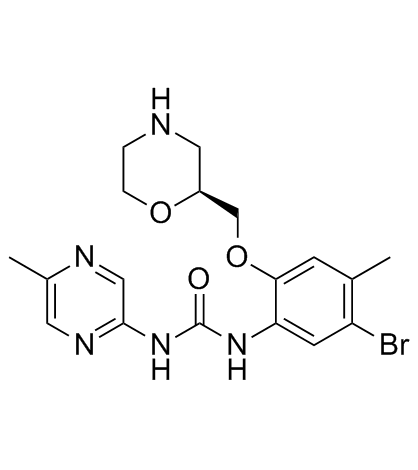LY2603618

LY2603618 structure
|
Common Name | LY2603618 | ||
|---|---|---|---|---|
| CAS Number | 911222-45-2 | Molecular Weight | 436.303 | |
| Density | 1.5±0.1 g/cm3 | Boiling Point | 503.1±50.0 °C at 760 mmHg | |
| Molecular Formula | C18H22BrN5O3 | Melting Point | N/A | |
| MSDS | N/A | Flash Point | 258.1±30.1 °C | |
Use of LY2603618LY2603618 is a potent and selective inhibitor of Chk1 with an IC50 of 7 nM. |
| Name | 1-[5-bromo-4-methyl-2-[[(2S)-morpholin-2-yl]methoxy]phenyl]-3-(5-methylpyrazin-2-yl)urea |
|---|---|
| Synonym | More Synonyms |
| Description | LY2603618 is a potent and selective inhibitor of Chk1 with an IC50 of 7 nM. |
|---|---|
| Related Catalog | |
| Target |
Chk1:7 nM (IC50) Chk2:12000 nM (IC50) PDK1:893 nM (IC50) CAMK2:1550 nM (IC50) VEGFR3:2128 nM (IC50) MET:2200 nM (IC50) JNK1:4930 nM (IC50) RSK2:5700 nM (IC50) NTRK1:12000 nM (IC50) |
| In Vitro | LY2603618 is a highly effective inhibitor of multiple aspects of Chk1 biology. LY2603618 is tested against a panel of 51 diverse protein kinases in vitro. With an IC50 of 7 nM for Chk1, LY2603618 is approximately 100-fold more potent against Chk1 than against any of the other protein kinases evaluated (PDK1, IC50=893 nM, others >1000 nM). LY2603618 effectively reduced Chk1 autophosphorylation with an EC50 of 430 nM. Inhibition of Chk1 by LY2603618 also effectively abrogated the G2/M DNA damage checkpoint in cells treated with DNA damaging agents. Treatment of cells with LY2603618 produced a cellular phenotype similar to that reported for depletion of Chk1 by RNAi. Inhibition of intracellular Chk1 by LY2603618 results in impaired DNA synthesis, elevated H2A.X phosphorylation indicative of DNA damage and premature entry into mitosis[1]. Treatments of the SK-N-BE(2) cells with variable concentrations of LY2603618 results in dose-dependent inhibition of cell growth determined by MTT assays with an IC50 of 10.81 µM[1]. |
| In Vivo | Mice bearing Calu-6 xenografts are treated with 150 mg/kg (IP) Gemcitabine and a single simultaneous 200 mg/kg oral dose of LY2603618. 200 mg/kg of LY2603618 is sufficient to inhibit 85 % of Chk1 autophosphorylation in vivo at 2 h. LY2603618 effectively reduces Gemcitabine-induced phosphorylation on Tlk serine 695 as well, supporting the cited report with a selective chemical inhibitor of Chk1[1]. |
| Kinase Assay | Protein kinase assays are performed variously. Assays are performed on the following protein kinases: ABL, AKT1, ARG, CAMK2, CDK1, CDK2, CHK1, CHK2, DAPK1, EGFR, EPHA1, EPHB2, EPHB3, EPHB4, ERK1, ERK2, FES, FGFR1, FGFR3, FGFR4, FGR, HCK, HER2, INSR, JNK1, JNK2, LCK, MET, NTRK1, NTRK2, p38α, p38β, p38δ, p38γ, p70S6K, PDGFRα, PDGFRβ,, PDK1, PKCα, ROCK2, ROS, RSK2, SGK1, SRC, SYK, TAK1, TYRO3, VEGFR2, VEGFR3, YES, ZAP70[1]. |
| Cell Assay | Cells are plated at 2.5×103 per well, on 96-well tissue culture plates and incubated for one cell doubling (18-24 h). Gemcitabine dilutions are set up by half-log steps across a final concentration range of 1-1000 nM. LY2603618 is prepared by dilutions in DMSO to 5000× final concentration, and then diluted 1000-fold into medium to generate 5× stocks for addition to wells. Approximately 24 h after Gemcitabine addition, LY2603618 is added. Each combination is done in triplicate. After a period of two cell doublings following LY2603618 addition, MTS/PMS reagent is added to each well according to the manufacturer’s instructions. Absorbance is read on a Spectra Max 250 spectrophotometer at 490 nm and the data analyzed with GraphPad Prism 4.0. Dose-response curves are fit by non-linear regression, with bottom fits constrained to 0 % inhibition[1]. |
| Animal Admin | Mice[1] Female Harlan athymic nude mice (26-28 g) are used for these studies. Tumor growth is initiated by subcutaneous injection of 1×106 Calu-6 cells in a 1:1 mixture of serum-free growth medium and Matrigel in the rear flank of each subject animal. When tumor volumes reach approximately 150 mm3 in size, the animals are randomized by tumor size and body weight, and placed into their respective treatment groups. Each animal receives 2 injections, one of either saline vehicle or 150 mg/kg Gemcitabine administered by intraperitoneal injection in a volume of 200 μL, and the other being the Captisol vehicle or LY2603618 administered orally in a volume of 200 μL. |
| References |
| Density | 1.5±0.1 g/cm3 |
|---|---|
| Boiling Point | 503.1±50.0 °C at 760 mmHg |
| Molecular Formula | C18H22BrN5O3 |
| Molecular Weight | 436.303 |
| Flash Point | 258.1±30.1 °C |
| Exact Mass | 435.090607 |
| PSA | 100.89000 |
| LogP | 2.10 |
| Vapour Pressure | 0.0±1.3 mmHg at 25°C |
| Index of Refraction | 1.633 |
| Storage condition | -20°C |
| 1-(5-bromo-4-methyl-2-{[(2S)-morpholin-2-yl]methoxy}phenyl)-3-(5-methylpyrazin-2-yl)urea |
| LY-2603618 |
| cc-579 |
| UNII-3S9L1NU6U7 |
| 1-{5-Bromo-4-methyl-2-[(2S)-2-morpholinylmethoxy]phenyl}-3-(5-methyl-2-pyrazinyl)urea |
| 3-{5-bromo-4-methyl-2-[(2S)-morpholin-2-ylmethoxy]phenyl}-1-(5-methylpyrazin-2-yl)urea |
| LY2603618 |
| Rabusertib (USAN/INN) |
| 1-[5-bromo-4-methyl-2-S-(morpholin-2-yl-methoxy)-phenyl]-3-(5-methyl-pyrazin-2-yl)-urea |
| Rabusertib [USAN] |
| Rabusertib |
| Urea, N-[5-bromo-4-methyl-2-[(2S)-2-morpholinylmethoxy]phenyl]-N'-(5-methyl-2-pyrazinyl)- |
| N-[5-Bromo-4-methyl-2-[(2S)-2-morpholinylmethoxy]phenyl]-N'-(5-methyl-2-pyrazinyl)urea |